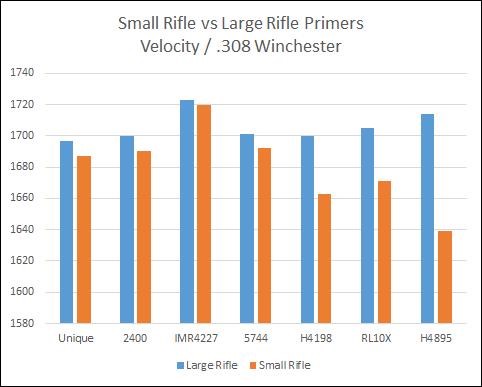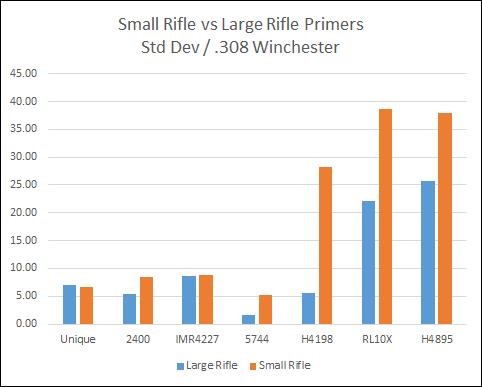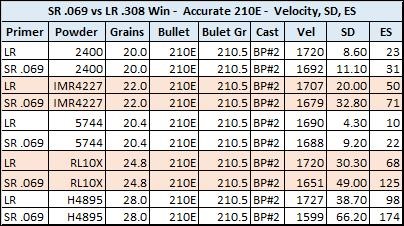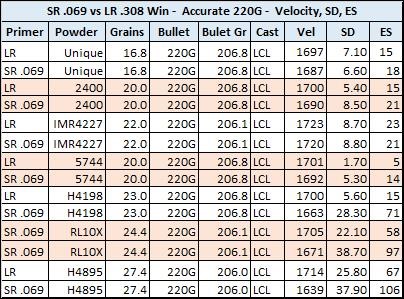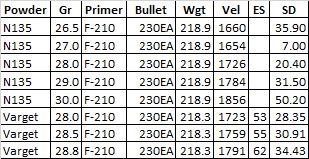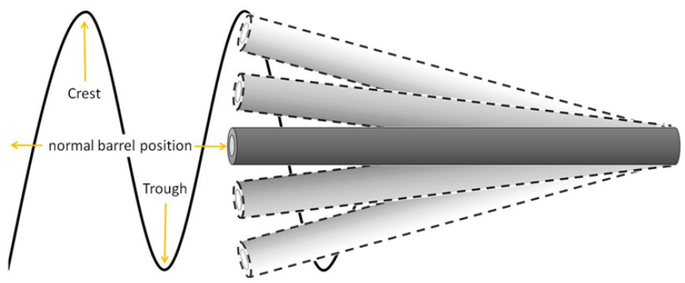This may give you a bit of insight. I now use cases with the flash holes drilled out for my 308W cast bullet match loads In LC Match cases, 16.5 gr Alliant 2400, 30 XCB bullets]. The last 10 shot test I chronographed (Oehler M35P gave and ES of 18 fps and an SD of 5 fps.
Drilled Flash Hole High Pressure Test; 308W
In the past I have posted this explanation of why I drill out flash holes for use with low end reduced loads.
“I shoot many thousands of squib loads in various calibers but mostly in .30s. Many of these are rimless cartridges; 30-06, .308, .308 CBC, 7.65, 7.62x39 etc. The squib loads I shoot most often is a Lee 314-90-SWC-TL over 2.7 to 3.2 gr of Bullseye depending on the cartridge. Velocity is around 800 – 875 fps. I found a long time ago the shoulders do in fact get set back with light loads such as those. With many cast loads that use normal weight bullets in the 1600 to 2000 fps range there was little setback. It basically is a matter of the psi the load generates. It takes roughly 7,000 psi (depends on thickness and hardness of the brass along with how much the case needs to reach the chamber walls.
Measurements of shoulder set back or increase are easily taken with a Stoney Point tool. There have been basically the two theories regarding the cause; the firing pin blow theory and the primer theory. I ran the same tests with a fire formed case and inert primers; headspace was not changed. I then used the same fire formed case with live primers. In as little as two firings there was a measurable decrease in headspace. After five live primers the fired primer was noticeably backed out after firing. NOTE: this increase in headspace was with case taking LR primers. I never experience the problem with the .222 Rem or the 5.56 NATO.
Using #d drills I gradually increased the flash hole diameter with a progressively larger drill. Using a different fire formed case with each larger drill and firing 5 primers I then measured the headspace before firing and after. As the size of the flash hole increased the headspace decrease lessoned. With a # 29 drill I no longer got any decrease in headspace. I dedicated five .308 cases and five 30-06 cases that were well fire formed to their respective rifles chambers and drilled the flash holes with the #29 drill. Over the next few days I fired 50 shots with each case. There was an indoor 50” range where I was stationed so it wasn’t all that bad. After the 50 firings there was negligible change in headspace with any of the five cases of each cartridge. The results of my test firmly demonstrated to me that it was the force of the primer explosion that drove the case forward and set back the shoulder. The squib load does not have the pressure to expand the case out to fit the chamber. By drilling out the flash hole the force of the explosion mostly went directly into the case as there is little rim left to contain it. Two other side benefits that were unforeseen; the extreme spread and standard deviations of the velocity readings improved and the case position sensitivity of the small charge was greatly reduced.
As a result of the above tests I dedicated fire formed cases for squib loads for each rifle in rimless cases and drill out the flash holes. I have fired them many, many times now with no further change in headspace. Besides the squib load mentioned I also use 311631 (# may be wrong but it’s the 118 gr GC 32-20 bullet) with Unique in the above cartridges loaded to 1400 fps or so for a little more powerful small game load. The flash hole drilled cases work just fine for those. I now use the flash ole drilled cases for all my rimless cartridges with squib and really light loads.
Further pressure testing in the .308W the last few years indicated that loads with a psi above 12,000 will obdurate sufficiently to prevent the primer from driving the case forward thus setting the shoulder back.”
Since then seems like every time the subject comes up we get admonitions not to do so because it is very “dangerous” should the cases with such drilled out flash holes be used for a “regular” load. Having Previously tested such cases with “regular cast bullets loads creating 28 – 30,000 psi (measured via an Oehler M43 PBL) I have endeavored to ascertain the danger of loading such to the psi of “regular” loads at 55,000 +/- psi.
I had enough cases LC 92 7.62 NATO (308W) cases I was going drill out the flash holes to run a series of 10 tests using five 9 shot tests and five 8 shot tests. I would run a test with the flash holes as they were (.061&rdquo and then increase them in size incrementally to .140”. That is the maximum size to enlarge the flash hole while still retaining enough of a shelf for the primer anvil legs to rest on. I used numbered (#) drills alternately from #44 up through #28 to enlarge the flash holes.
and then increase them in size incrementally to .140”. That is the maximum size to enlarge the flash hole while still retaining enough of a shelf for the primer anvil legs to rest on. I used numbered (#) drills alternately from #44 up through #28 to enlarge the flash holes.
Here we see the cases with the flash holes drilled from “as issued” on the left to #28 drilled on the right;

The cases were FL sized in a RCBS X-die the loaded with pull down M80 bullets (147 gr FMJBT) over 43 gr of IMR 4895 with WLR primers. The loads were tested on 2/25/2019 in my test rifle with a 24” barrel. The Oehler M43 PBL was used to measure velocity, pressure, etc. I could see no difference in the appearance of the primers after firing. Have a look for yourself;
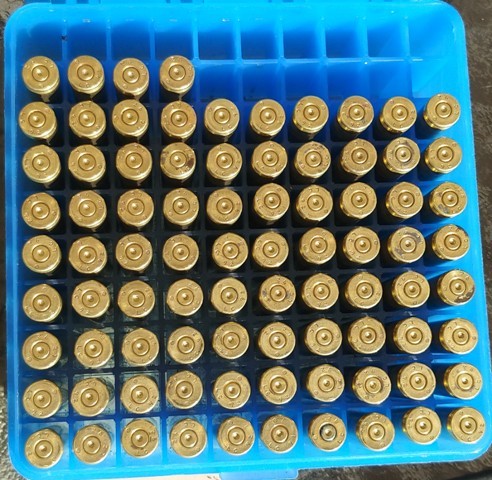
Here is a compilation of all the data measured during the test. I’ll be darned if I can see any meaningful difference between the first load with “regular” .061” flash holes and the last test with .140”.
 Throughout the test the sky did not fall, Humpty did not fall off the wall, the chicken made it across the road and no collusion between Trump and the Russians was found………and I’m still alive and the rifle did not blow up……… It appears, based on actual test results, using cases with drilled out flash holes might not be as “dangerous” as some thought………
Throughout the test the sky did not fall, Humpty did not fall off the wall, the chicken made it across the road and no collusion between Trump and the Russians was found………and I’m still alive and the rifle did not blow up……… It appears, based on actual test results, using cases with drilled out flash holes might not be as “dangerous” as some thought………
Completed the 2nd test using 168 MKs over 41.5 gr IMR 4895 yesterday. Shot four 9 shot test groups using the cases with; flash holes as issued, then three other groups with flash holes drilled with #40 drill (.096"), #34 (.111") and #28 (.140"). The results;
With as issued flash holes: 2653 fps SD 16 fps/ES 53 fps; 56,000 psi SD 1,600/ES 4,800; group 1.69"
With #40 drill (.096") drill: 2646 fps SD 9 fps/ES 31 fps; 54,900 psi SD 1,300/ES 4,200; group 1.45"
With #34 drill (.111") drill: 2646 fps SD 19 fps/ES 61 fps; 54,700 psi SD 1,800/ES 6,000; group 1.37"
With #28 drill (.140) drill: 2641 fps SD 12 fps/ES 43 fps; 54,000 psi SD 1,100/ES 3,000; group .945"
The first 2 shots (foulers) were slightly out of the group and gave the 2 highest FPS and psi. That raised the averages above the others slightly. The test rifle normally shoots 10 shots into an average of 1.2 - 1.4".
All the data are once again within the normal test to test variation of the same load. Nothing indicates any "danger" from using cases with drilled flash holes, even with normal high pressure loads with jacketed bullets.
Again, the benefit of using such cases (those with LR primers) is with gallery type loads (cat's sneeze, mouse fart, squib, etc.) that do not generate sufficient psi to obturate the case. Using such cases in push feed actions, especially those with a plunger ejector, w/o drilling the flash holes can lead to shortened case headspace which then leads to failure to fire and/or failure to extract. Drilling the flash holes out alleviates that problem with these type loads.
"I never was concerned about increased pressure of the powder charge from larger flash holes. I do have a mild concern about increased pressure in the primer itself increasing the chance of a blanked or pierced primer."
That is one of the main concerns that is always expressed. If there was greater pressure in the primer with a drilled out flash hole than with a standard flash hole don't you think it would manifest itself in a greater flattening of the primer? Yet we don't see that at all in either test. The flatness of the fired primers regardless of flash hole size is identical. Thus far I have fired 136 cartridges at 56 t0 57,000 psi (measured) w/o a single indication of any greater primer flattening with drilled flash holes vs "standard" flash holes.
Perhaps there actually isn't any greater increase in pressure inside the primer? Or if there is an increase it is not a sufficient increase to pose any problem or danger. There was absolutely no indication there was in increase in pressure inside the primer cups.
A further argument, if not the main argument, against the use of drilled out flash hole cases for gallery loads is that if you inadvertently use them with a standard load it could be dangerous. Thus, if you have a standard load that doesn't pierce or blow the primer and inadvertently use a case with drilled flash holes it appears there really isn't any concern. I am not suggesting whatsoever that full power loads be developed and used with cases having drilled out flash holes……I do not do that. The point of this test was to determine if there is a danger from increased pressure if using a case with a drilled out flash hole.
What I am suggesting is the use of such cases with drilled out flash holes should be used with gallery or other low level cast bullet loads. The purpose of drilling out flash holes for use with gallery or other low level loads is to negate the headspace of the case from shortening with repeated firing from the primer pressure in push feed actions. That is all.
LMG
Concealment is not cover.........








